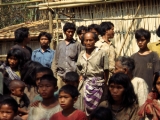
Mlabri
Encyclopedia
The Mlabri or Mrabri are an ethnic group of Thailand
and Laos
, and have been called "the most interesting and least understood people in Southeast Asia". Only about 300 or fewer Mlabris remain in the world today, with some estimates as low as 100. A hill tribe in northern Thailand
along the border with Laos
, they have been groups of nomadic hunter-gatherer
s. The group in Thailand live close to the Hmong and northern Thai. The group living in Laos live close to other ethnic groups as well.
, mra means "person" and bri "forest". They are also known locally as Phi Tong Luang (Thai: ผีตองเหลือง, Lao: ຜີຕອງເຫລືອງ) or "spirits of the yellow leaves", apparently because they abandon their shelters when the leaves begin to turn yellow.
in 2005 in an exchange of articles between Hiroki Oota and colleagues, and Tony Waters.
They have few regimented social ceremonies, and are said to have no religious system to speak of, although it is reported that they believe in some spirits of the forest and other natural features. Marriages are concluded after simple request, with no bride-price, and the dead are buried near where they died before the tribe moves on.
Austrian anthropologist Hugo Bernatzik
published an ethnography of the "Yellow Leaf People" in 1938 which reflected his brief observations of the tribe in the mid-20th century.
Thailand
Thailand , officially the Kingdom of Thailand , formerly known as Siam , is a country located at the centre of the Indochina peninsula and Southeast Asia. It is bordered to the north by Burma and Laos, to the east by Laos and Cambodia, to the south by the Gulf of Thailand and Malaysia, and to the...
and Laos
Laos
Laos Lao: ສາທາລະນະລັດ ປະຊາທິປະໄຕ ປະຊາຊົນລາວ Sathalanalat Paxathipatai Paxaxon Lao, officially the Lao People's Democratic Republic, is a landlocked country in Southeast Asia, bordered by Burma and China to the northwest, Vietnam to the east, Cambodia to the south and Thailand to the west...
, and have been called "the most interesting and least understood people in Southeast Asia". Only about 300 or fewer Mlabris remain in the world today, with some estimates as low as 100. A hill tribe in northern Thailand
Thailand
Thailand , officially the Kingdom of Thailand , formerly known as Siam , is a country located at the centre of the Indochina peninsula and Southeast Asia. It is bordered to the north by Burma and Laos, to the east by Laos and Cambodia, to the south by the Gulf of Thailand and Malaysia, and to the...
along the border with Laos
Laos
Laos Lao: ສາທາລະນະລັດ ປະຊາທິປະໄຕ ປະຊາຊົນລາວ Sathalanalat Paxathipatai Paxaxon Lao, officially the Lao People's Democratic Republic, is a landlocked country in Southeast Asia, bordered by Burma and China to the northwest, Vietnam to the east, Cambodia to the south and Thailand to the west...
, they have been groups of nomadic hunter-gatherer
Hunter-gatherer
A hunter-gatherer or forage society is one in which most or all food is obtained from wild plants and animals, in contrast to agricultural societies which rely mainly on domesticated species. Hunting and gathering was the ancestral subsistence mode of Homo, and all modern humans were...
s. The group in Thailand live close to the Hmong and northern Thai. The group living in Laos live close to other ethnic groups as well.
Nomenclature
The name Mlabri is a Thai/Lao alteration of the word Mrabri, which appears to come from a Khmuic term "people of the forest" – in KhmuKhmu language
Khmu is the language of the Khmu people of the northern Laos region. It is also spoken in adjacent areas of Vietnam, Thailand and China. Khmu lends its name to the Khmuic branch of the Austro-Asiatic language family, which also includes Khmer and Vietnamese. Within Austro-Asiatic, Khmu is often...
, mra means "person" and bri "forest". They are also known locally as Phi Tong Luang (Thai: ผีตองเหลือง, Lao: ຜີຕອງເຫລືອງ) or "spirits of the yellow leaves", apparently because they abandon their shelters when the leaves begin to turn yellow.
Genetics
Genetic analysis of the Mlabri group by Hiroki Oota and colleagues led them to observe that the mtDNA has little diversity, suggesting to them that the Mlabris were founded 500–800 years ago from very few individuals. This hypothesis was contested in the journal PLoS BiologyPLoS Biology
PLoS Biology is a peer-reviewed scientific journal covering all aspects of biology. Publication began on October 13, 2003.It was the first journal of the Public Library of Science. All content in PLoS Biology is published under the Creative Commons "by-attribution" license...
in 2005 in an exchange of articles between Hiroki Oota and colleagues, and Tony Waters.
Lifestyle
The Mlabri live an extremely primitive lifestyle. They are nomadic and have no real houses, making instead temporary shelters from palm leaves and bamboo-string. Previously they wore a loin-covering of bark or cloth, though now most Mlabri wear old factory-produced clothes procured by trade with other tribes in the area. They are hunter-gatherers, although far more of their food comes from gathering than hunting. Women give birth alone in the forest and infant mortality is very high.They have few regimented social ceremonies, and are said to have no religious system to speak of, although it is reported that they believe in some spirits of the forest and other natural features. Marriages are concluded after simple request, with no bride-price, and the dead are buried near where they died before the tribe moves on.
Austrian anthropologist Hugo Bernatzik
Hugo Bernatzik
Hugo Adolf Bernatzik , was an Austrian anthropologist and photographer.Bernatzik was the founder of the concept of alternative anthropology.-Biography:...
published an ethnography of the "Yellow Leaf People" in 1938 which reflected his brief observations of the tribe in the mid-20th century.
External links
- MlaBri People - page with photographs of Mlabri people.

